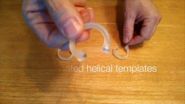Molecular Lego of knots
A virtual archive of building blocks to create nano-knots of all shapes and forms
2015-03-10
(Press-News.org) As sailors and mountaineers know very well, every knot carries out a specific function. There's a knot that slides, one that "floats", and one that comes undone with a single pull. In the field of nanotechnology as well, it is useful to have several kinds of molecular knots to be used, for instance, as mechanically resistant nano-cages for delivering chemical compounds or for confining and controlling toxic reagents. So far, molecular knots have only been produced by chemical synthesis, obtaining constructs on an atomic scale. In the study coordinated by SISSA professor Cristian Micheletti, a team of researchers (from the Universities of Edinburgh and Padova as well as from SISSA) have tackled a previously unmet challenge: obtaining larger-scale knots starting from molecular building blocks with a specific shape and "sticky" ends allowing the fragments to assemble themselves spontaneously. Left free to move and interact in a solution, these fragments stick to one another to form complex three-dimensional units. How can we exploit this process to obtain a knot that has a specific shape? "It is necessary to study precisely the shape of the fragment", explains Cristian Micheletti, SISSA scientist and study coordinator. "So first we did that by using computer simulations and then we drew up a 'catalogue' of fragments for each use". The results have just been published in Nature Communications.
The study simulated the self-assembly of differently shaped fragments interacting in a virtual solution, successively modifying specific parameters in the shape of the fragments. "This way we selected the most suitable shapes for assembling various types of knots" explains Micheletti.
Molecular knots may find application in the field of nanotechnology, to construct nanodevices serving different functions. "Our study", concludes Guido Polles, SISSA student and first author of the paper, "should serve as a guide for experimentalists who can now choose which molecular knots to produce taking into account the ease or difficulty with which each knot will spontaneously self-assemble".
"So far, all endeavours to 'design' molecular knots", continues Micheletti, "have followed the natural progression of the mathematical complexity of the knots. We discovered that this natural scale of complexity does not necessarily correlate with ease of assembly". This means that knots that are mathematically very complex may be relatively easy to assemble. "More specifically, we identified a type of knot with a particularly complex three-dimensional shape," concludes Micheletti, "which surprisingly can be assembled very efficiently starting from only four helical fragments. This makes it the most promising and interesting candidate for experimental realisation in the laboratory".
INFORMATION:
Watch video with real "building blocks" demonstration on youtube: http://youtu.be/XKsuMlp2PLc
Additional pictures can be downloaded (at full resolution) here: http://goo.gl/XUNqQE
ELSE PRESS RELEASES FROM THIS DATE:
2015-03-10
DENVER (March 10, 2015) - As branding and advertising creep into almost every facet of life, a new study from the University of Colorado Denver shows it's now making substantial inroads into popular music.
The study examined in detail the yearly top 30 Billboard songs from 1960 to 2013 - a total of 1,583 - and found a steep increase in `advertainment' or the use of product placement, branding and name dropping among the most popular music in the nation.
In 2006 alone, 20 of the top 30 songs, or two out of three, included at least one reference to a person, place or ...
2015-03-10
Researchers at the Veterans Affairs San Diego Healthcare System and University of California, San Diego School of Medicine, with colleagues in New York and the United Kingdom, have identified genetic markers, derived from blood samples that are linked to post-traumatic stress disorder (PTSD). The markers are associated with gene networks that regulate innate immune function and interferon signaling.
The findings, published in the March 10 issue of the journal Molecular Psychiatry, offer novel insights into the pathophysiology of PTSD. In clinical terms, researchers say ...
2015-03-10
Ithaca, NY--What inspires people to support conservation? As concerns grow about the sustainability of our modern society, this question becomes more important. A new study by researchers at Cornell University provides one simple answer: bird watching and hunting.
This survey of conservation activity among rural landowners in Upstate New York considered a range of possible predictors such as gender, age, education, political ideology, and beliefs about the environment. All other factors being equal, bird watchers are about five times as likely, and hunters about four ...
2015-03-10
Philadelphia, PA, March 10, 2015 - In a study published in the Journal of the Academy of Nutrition and Dietetics, researchers from the RAND Corporation report that for people receiving food assistance there are significant links between depression, poor dietary quality, and high body mass index (BMI). They suggest that understanding the risk of depression among Supplemental Nutrition Assistance Program (SNAP) participants could be important to understanding the relationship among SNAP participation, diet, and weight.
"This study focuses on a group that is of particular ...
2015-03-10
New evidence published today in the Cochrane Library shows that hormone replacement therapy does not protect post-menopausal women against cardiovascular disease, and may even cause an increased risk of stroke.
HRT, now more commonly known as hormone therapy, is widely used for controlling menopausal symptoms. It has also been used for the prevention of cardiovascular disease in post-menopausal women. This latest evidence looked at the effects of using hormone therapy for at least six months and involved more than 40,000 women across the world.
The length of time women ...
2015-03-10
WASHINGTON, DC - March 10, 2015 - Households can serve as a reservoir for transmitting methicillin-resistant Staphylococcus aureus (MRSA), according to a study published this week in mBio®, the online open-access journal of the American Society for Microbiology. Once the bacteria enters a home, it can linger for years, spreading from person to person and evolving genetically to become unique to that household.
MRSA are strains of the bacterium Staphylococcus aureus that are resistant to almost all antibiotics related to penicillin, known as the beta-lactams. Since ...
2015-03-09
Middle-aged Americans who show high levels of societal involvement and mental health are especially likely to construe their lives as stories of personal redemption, according to new research published in Psychological Science, a journal of the Association for Psychological Science.
Previous research has shown that adults who are inclined toward generativity - the concern for and commitment to promoting the growth and well-being of future generations - are more likely to engage in a wide range of prosocial behaviors, including positive parenting styles, political participation, ...
2015-03-09
Everything is connected, especially in the brain. A protein called BAI1, involved in limiting the growth of brain tumors, is also critical for spatial learning and memory, researchers have discovered.
Mice missing BAI1 have trouble learning and remembering where they have been. Because of the loss of BAI1, their neurons have changes in how they respond to electrical stimulation and subtle alterations in parts of the cell needed for information processing.
The findings may have implications for developing treatments for neurological diseases, because BAI1 is part of ...
2015-03-09
BOSTON, MA - Healthcare spending is at an all-time high in the U.S., yet young African-American men see little benefit, according to Boston Medical Center (BMC) researchers' Viewpoint commentary published in the current issue of the Journal of the American Medical Association (JAMA).
The researchers note that black men have a life expectancy nearly five years less than white men. While heart disease and cancer contribute to this decreased life expectancy, homicide also plays a large role. From ages 1 to 14, homicide is either the second or third leading cause of death ...
2015-03-09
As obesity rates rise, so does the incidence of type 2 diabetes (T2D). In obese individuals and those with obesity-induced T2D, there is an accumulation of immune cells within adipose tissue that results in a low level of chronic inflammation. Gut microbial populations are also altered in these individuals. Weight loss, either through diet or gastric bypass, improves TD2-associated symptoms and shifts the gut microbiota. A new study in the Journal of Clinical Investigation reports that a population of T cells known as mucosal-associated invariant T (MAIT) cells is altered ...
LAST 30 PRESS RELEASES:
[Press-News.org] Molecular Lego of knots
A virtual archive of building blocks to create nano-knots of all shapes and forms


